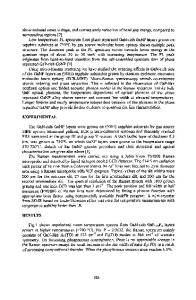Kinetics of short- and long-range B2 ordering in ternary alloys
- PDF / 823,360 Bytes
- 9 Pages / 612 x 828 pts Page_size
- 98 Downloads / 349 Views
The kinetics of disorder —> B2 order transformations in ternary alloys were studied in the pair approximation. The predictions of two sets of rate equations were compared, one based on an atom-atom interchange mechanism and the other based on an atom-vacancy interchange mechanism. Examples are presented to show how the evolution of order is affected by differences in interatomic potentials, differences in activation barrier heights, and effects of vacancy ordering. A wide variety of states of order are possible during the disorder —> order transformation in ternary alloys, and qualitative features of the sequences of these states are discussed. The sequences of states, or "kinetic paths", are much less intuitive than for binary alloys.
I. INTRODUCTION In chemical disorder —> order transformations, the mechanism of atom movements brings features to the transformation that are missing from thermodynamics. Differences in activation barrier heights and many details of the interatomic interaction potentials for the different atomic species do not affect thermodynamic end states. They do, however, affect the rate of approach to equilibrium1'4 and the "kinetic path" taken by the alloy.5-6 When vacancies are the agents for atom movements, the kinetics of atom-vacancy interchanges are modified by the state of short- and long-range order (SRO and LRO) of the vacancy distribution.7-8 The present study of the disorder —> B2 order transformation in ternary alloys followed the application of the Master Equation Method (MEM) for ordering in binary alloys.9 The state of the alloy is expressed as a set of pair variables, which are probabilities that two neighboring lattice sites are occupied by a specific pair of atoms (see Sec. II for precise definitions). More complicated clusters of atoms are ignored, so the theory is a "pair approximation". Rate equations were obtained from the MEM for atom movements by (1) the direct interchange of an atom with an adjacent first-nearest neighbor atom (atom-atom interchange), and (2) the interchange of an atom and an adjacent vacancy (vacancy mechanism). In previous calculations for simpler binary alloys, the independence of the SRO and LRO relaxations was studied.3'4'9^11 Ternary alloys have more independent order parameters.5'12'13 For a given number of A-atoms on the A-rich a-sublattice, N£, the remaining sites on the a-sublattice can be occupied by any combination of the point variables Ng and N, c> subject only to the one equation: (1)
946
http://journals.cambridge.org
J. Mater. Res., Vol. 7, No. 4, Apr 1992
Downloaded: 16 Mar 2015
where N is the total number of sites in the alloy, and i denotes the different species, A, B, and C. Similarly for the SRO pair variables, given a particular number of A-atoms situated as nearest neighbors to an A-atom, the other A-B and A-C pairs are not individually specified in the B2 structure. This independence of variables allows the kinetics of ordering to be sensitive to the mechanism of ordering. (Such sensitivity cannot occur for B2 ordering in b
Data Loading...











